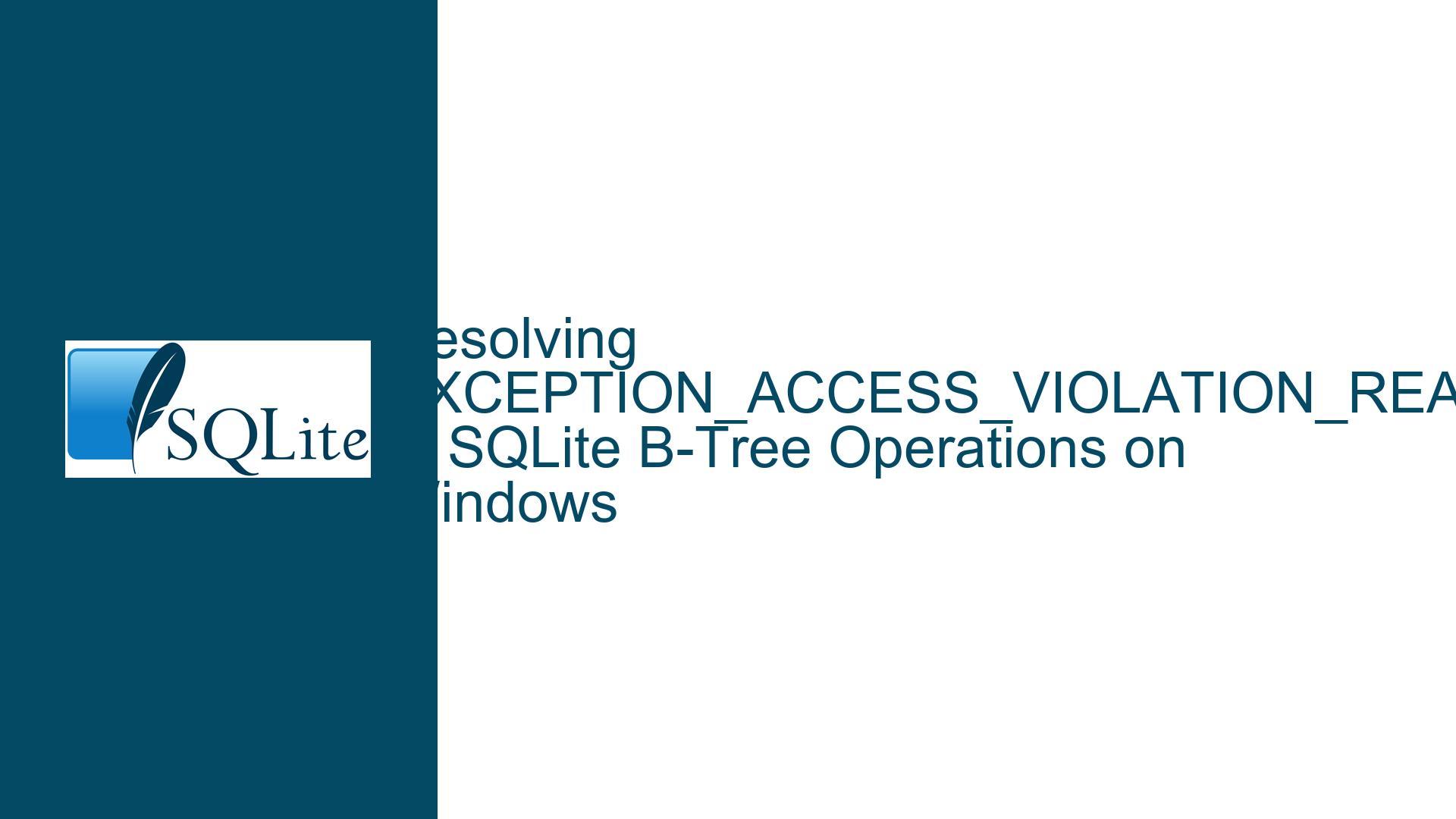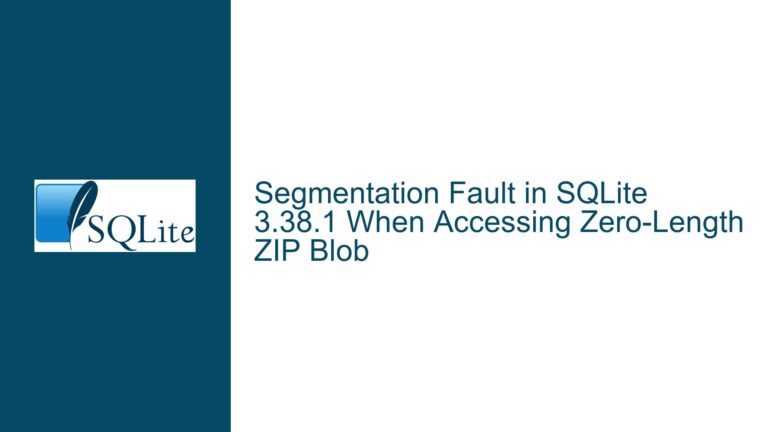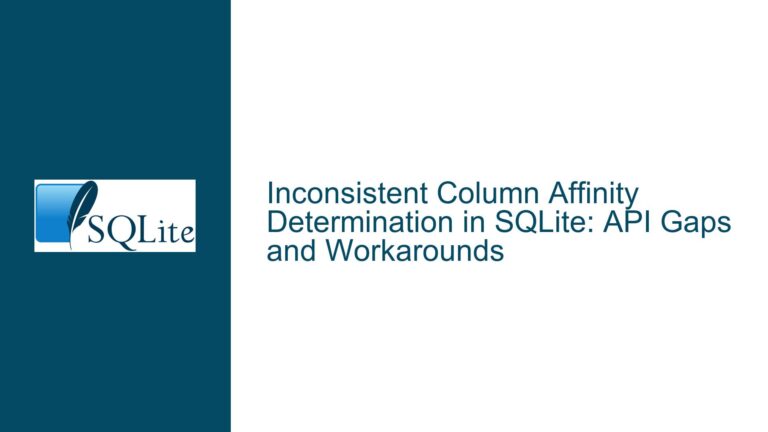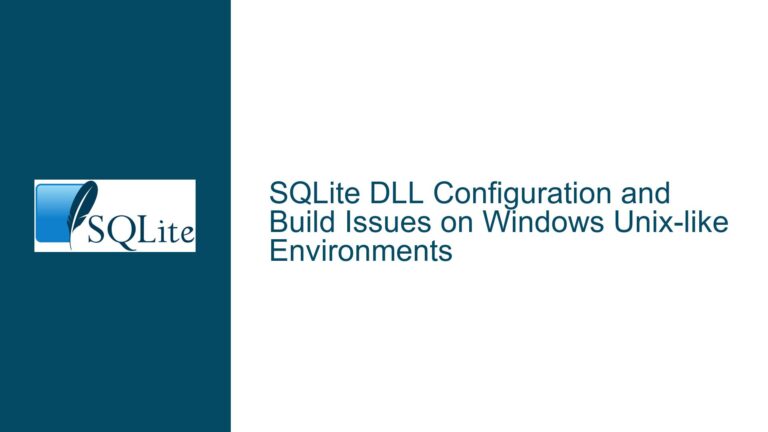Resolving EXCEPTION_ACCESS_VIOLATION_READ in SQLite B-Tree Operations on Windows
Understanding the EXCEPTION_ACCESS_VIOLATION_READ During B-Tree Traversal
Root Cause Analysis for SQLite moveToLeftmost Crash
1. The Anatomy of the EXCEPTION_ACCESS_VIOLATION_READ in SQLite3BtreeFirst
The crash manifests as an EXCEPTION_ACCESS_VIOLATION_READ during execution of sqlite3BtreeFirst, specifically within the moveToLeftmost function. The stack trace indicates a read access violation at address 0x75, which is a null or invalid memory address. The registers at the time of the crash show eax as 0x0, suggesting an attempt to dereference a null pointer or access memory that has been freed or corrupted. The SQLite function moveToLeftmost is part of the B-tree traversal logic used to navigate to the leftmost cell in a database page. This function is critical for operations like table scans or index lookups. A failure here implies structural corruption in the B-tree, invalid page handles, or memory that SQLite expects to be valid but is not.
The crash occurs in a Windows application using SQLite 3.41.2, with partial stack symbols showing interactions between agent.exe, sentry.dll, and system libraries like ntdll.dll. The presence of std::_Tree_const_iterator and boost::signals2 in the stack suggests concurrent data structure manipulation in C++ code, which may intersect with SQLite operations. The unsymbolicated sentry.dll complicates diagnosis, as Sentry is a crash reporting tool that may interfere with stack unwinding or memory management.
Key observations from the trace:
- The crash originates in SQLite’s B-tree traversal during a
VdbeExecoperation (SQLite virtual machine execution). - The
RtlpDosPathNameToRelativeNtPathNameandRtlAllocateHeapin the stack hint at filesystem or heap interactions, possibly during database file I/O. - The
std::_Tree_const_iteratorcomparisons suggest concurrent access to STL containers in the application, raising questions about thread safety.
2. Common Triggers for Memory Corruption and Invalid B-Tree State
Memory Corruption in Client Application
SQLite relies on the host application’s memory allocator (typically the C runtime’s malloc/free). If the application corrupts the heap (e.g., buffer overflows, use-after-free, double frees), SQLite’s internal data structures (B-tree pages, cursor objects) may reference invalid memory. For example:
- A buffer overflow in application code could overwrite SQLite’s
BtCursorstructure, causingmoveToLeftmostto dereference a nullpPagepointer. - Thread-unsafe use of SQLite connections (e.g., sharing a database handle across threads without mutexes) can lead to race conditions where a cursor is invalidated mid-traversal.
Database File Corruption
While SQLite has robust safeguards against file corruption, hardware faults, filesystem bugs, or improper fsync handling can leave the database in an inconsistent state. A corrupted database page loaded into memory might have invalid cell offsets, causing moveToLeftmost to compute an incorrect memory address.
Third-Party Library Interference
Libraries like Sentry (via sentry.dll) that hook into memory allocation or exception handling can destabilize SQLite. For instance:
- Sentry’s crash reporter might install a custom exception handler that conflicts with SQLite’s error recovery mechanisms.
- Heap profiling tools often replace allocators, introducing overhead or fragmentation that exacerbates latent bugs.
Windows-Specific Heap Management Issues
The referenced Microsoft thread discusses a memory leak in RtlAllocateHeap, which could fragment the heap over time. If SQLite’s allocator requests a block that ntdll.dll returns as invalid, subsequent B-tree operations might access unmapped memory. This is rare but possible in long-running processes with heavy memory churn.
SQLite Version-Specific Bugs
Although SQLite 3.41.2 has no known bugs matching this crash, edge cases in B-tree handling (e.g., WITHOUT ROWID tables, virtual tables) might surface under specific workloads. For example, a cursor left in an invalid state after a ROLLBACK could cause sqlite3BtreeFirst to access freed pages.
3. Systematic Diagnosis and Remediation Strategies
Step 1: Validate the Stack Trace and Environment
- Reproduce with Debug Symbols: Rebuild the application and SQLite with debug symbols to resolve
<unknown>frames. Use WinDbg or Visual Studio to capture a full crash dump. - Isolate Third-Party Components: Temporarily disable Sentry and Boost libraries to rule out interference. If the crash disappears, investigate their integration (e.g., thread-local storage usage in Boost.Signals2).
- Test on Clean Windows Instances: Rule out system-wide heap corruption by running the application on a fresh VM or machine.
Step 2: Rule Out Memory Corruption
- Enable SQLite’s Debug Checks: Compile SQLite with
-DSQLITE_DEBUGand-DSQLITE_ENABLE_API_ARMORto enable internal consistency checks. These will abort with detailed messages if corruption is detected. - Use AddressSanitizer (ASan): Instrument the application with ASan to detect heap buffer overflows, use-after-free, and other memory errors. Example workflow:
# Build SQLite and application with Clang and -fsanitize=address clang -fsanitize=address -DSQLITE_DEBUG -o agent.exe agent.c sqlite3.c - Leverage Windows-Specific Tools:
- Enable Page Heap (
gflags.exe /p /enable agent.exe /full) to place guard pages around allocations. - Use Application Verifier to monitor handle usage and heap operations.
- Enable Page Heap (
Step 3: Audit SQLite Usage Patterns
- Check Threading Model: Ensure each SQLite database connection is used by only one thread at a time. Wrap connections in mutexes if shared. Verify that
SQLITE_THREADSAFE=1is set at compile time. - Inspect Transaction Boundaries: Use
sqlite3_get_autocommit()to confirm transactions are properly finalized. A missingsqlite3_finalize()after aBEGIN IMMEDIATEcould leave a cursor open. - Validate Prepared Statements: Ensure all
sqlite3_stmtobjects are reset (sqlite3_reset()) or finalized before reusing connections.
Step 4: Database Integrity Checks
- Run
PRAGMA integrity_check;andPRAGMA quick_check;to identify logical or structural corruption. If errors are found, attempt recovery using.recoverorsqlite3_db_cacheflush(). - Verify the database file’s journal mode (
PRAGMA journal_mode;). If usingWAL, check for stale-walor-shmfiles.
Step 5: Upgrade and Regression Testing
- Update SQLite: While 3.41.2 has no known fixes for this issue, newer versions (e.g., 3.45.1) include optimizations for B-tree traversal and Windows VFS. Test with the latest amalgamation.
- Regression Testing: If the crash is intermittent, use a test harness to replay database operations under varying load. Tools like
SQLiteTestor custom scripts can automate this.
Step 6: Custom Allocator and Instrumentation
- Override SQLite’s Allocator: Use
sqlite3_config(SQLITE_CONFIG_HEAP, ...)to allocate from a dedicated memory pool. Monitor this pool for overruns. - Log Memory Operations: Wrap
mallocandfreewith logging functions to track allocations associated with SQLite cursors and pages.
Step 7: Low-Level Debugging Techniques
- Set Breakpoints on B-Tree Functions: In WinDbg, break on
sqlite3BtreeFirstand inspect theBtCursorstructure:bp agent.exe!sqlite3BtreeFirst "dt SQLite::BtCursor @ecx; g"Check
pCursor->pPageandpCursor->pBtree->pBtfor validity. - Analyze Heap Blocks: Use
!heap -p -a <address>to determine if the accessed memory is freed or corrupted.
Final Fixes and Workarounds
- If memory corruption is confirmed, refactor the application to use RAII patterns for SQLite objects (e.g., smart pointers for
sqlite3_stmt). - For suspected Windows heap issues, switch to SQLite’s memory-mapped I/O (
PRAGMA mmap_size=...) to reduce reliance on the heap allocator. - Implement a watchdog thread that periodically checks database health using
sqlite3_db_status()andsqlite3_memory_used().
By methodically isolating components, instrumenting memory, and validating SQLite’s internal state, developers can pinpoint whether the crash stems from application-level memory misuse, third-party interference, or an environmental anomaly. In most cases, rigorous use of sanitizers and debug builds will surface the root cause within hours.






